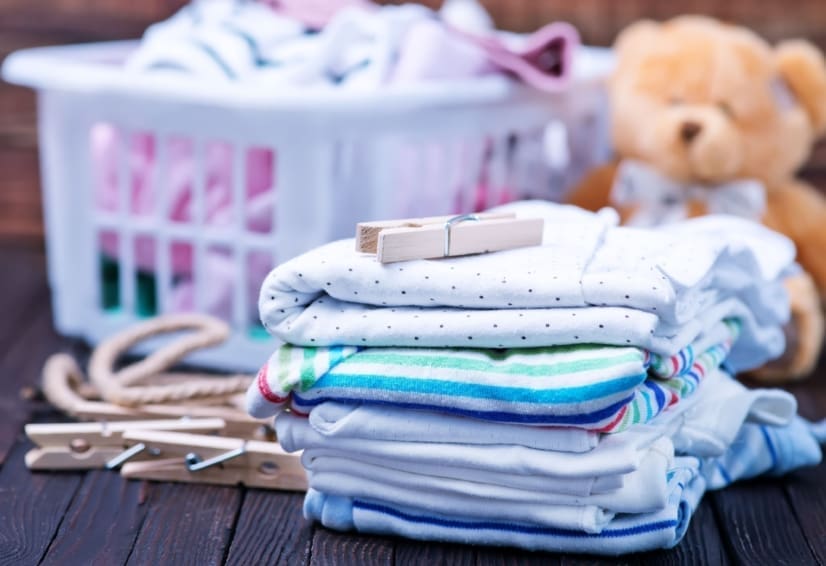
Doing your laundry seems like a simple task that requires little thought. However, add tiny newborn clothes and bedding to the mix and suddenly you are spending more time on laundry than you ever imagined. Here is everything you should keep in mind as you look to all those loads of laundry.
Path to better health
Newborns make big messes with their laundry and may require more frequent washing, since newborn clothing may be exposed to bodily fluids.
If you have a newborn in your home, remember these tips:
- Use a laundry detergent made for newborns. This will reduce skin irritation.
- Wash baby laundry separately from the rest of the household. This helps prevent the spread of germs or bacteria. If someone in your home is sick, you may consider washing their clothes in water that is a higher temperature or add bleach if you can. Always wash your hands after handling this laundry.
- Treat stains immediately. This is the best shot for getting rid of the stain.
- Separate laundry by degree of stain and contamination. For example, if you use reusable diapers, wash those separately from other baby clothing.
- Store all laundry detergent and additives safely out of sight and reach of children. Store products in their original containers with labels intact. In the event of an accidental exposure, call your local poison control center at 1-800-222-1222.
Diaper duty
If you are using cloth diapers with your baby, you will treat and wash these separately from all other laundry. It may seem intimidating at first, but once you have the process down, laundering cloth diapers is not difficult.
First, check the manufacturer’s directions for laundering the diapers and use those recommendations. In general, you can divide cloth diaper duty into three categories:
- Prep the diapers. Do this by removing any solid waste. You may also use a diaper sprayer to help with this. Place the diaper in a diaper pail or bag until you are ready to launder (plan to wash a load of diapers at least every other day).
- Wash the diapers. First, run the diapers through the rinse cycle. Then, you will wash them according to the fabric instructions or manufacturer’s guidelines.
- Dry the diapers. Cloth diapers last longer if you air dry them. Air drying also helps them maintain their waterproofing.
Stain steps
The best way to prevent stains is to get to them before they set. This isn’t always possible—especially when you are caring for a baby. Here are some suggestions for some of the most common baby laundry stains. Also, do not put clothing in the dryer until you know the stain is gone. Otherwise, the heat from the dryer can set the stain.
- Baby oil. Getting oil-based stains out of fabric can be tough. If you get baby oil on clothes, first soak up the excess oil with paper towel and pretreat the stain with a stain remover. Launder as soon as you can on the hottest temperature that is safe for the fabric (check the label).
- Breast milk/formula/spit up. Probably the most culprit for stained baby clothes, breast milk/formula/spit up stains can be difficult to treat. Your best bet is to pretreat the stain as soon as possible and then let the clothing soak for at least 30 minutes. For older stains, you may need to soak for several hours. Then launder.
- Another common stain for baby laundry, poop stains are a little easier to erase. First, use a baby wipe to remove what you can, then rinse the clothing item in cold water with dish soap before laundering. Do not put clothing in the dyer until the stain is fully gone, as this may set the stain.
A refresher on laundry for the whole family
The first thing to consider when doing laundry is hygiene. Each day, our clothing comes into contact with many things, including our own body’s personal hygiene. Bodily fluids, bacteria, and sweat touches nearly everything we wear, from underwear to tops and hats.
Clothes also come into contact with allergens, such as mold, animal dander and pollen.
Washing tips
Sorting laundry isn’t only separating dark clothes and lights. You should also consider wash cycles and temperatures. Start by checking clothes labels and grouping laundry accordingly. Nearly everyone knows to check the clothing label, but did you also know you should read your laundry detergent’s instruction label, as well? Doing so will let you know how much detergent you need (more isn’t always better!).
Things to consider
Washing your clothes with the right temperature will save you money and help the environment. For example, using hot water takes more energy to heat the water and impacts your utility bill. So, save hot water for laundering when someone in the house is sick or is immuno-compromised. Also, remember to set your dryer to the appropriate setting. Not all clothes need to be dried on the hottest setting. This impacts your utility bill and the environment. Various drying cycles are recommended for different clothing. Read your dryer settings before each use. Some items might even do better or just as well when hung dry. And although hanging your clothes outside might seem like the most affordable method, this will expose them to allergens, such as pollen. It’s best to hang dry clothing indoors.
Questions to ask your doctor
- Can I get ill from wearing clothing that is exposed to bacteria?
- Can laundry detergent irritate my skin?
Resources
![]()
Copyright © American Academy of Family Physicians
This information provides a general overview and may not apply to everyone. Talk to your family doctor to find out if this information applies to you and to get more information on this subject.




